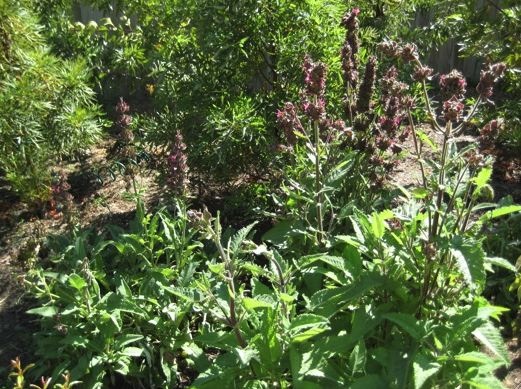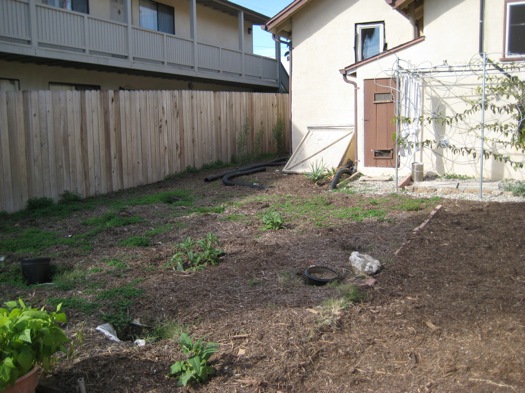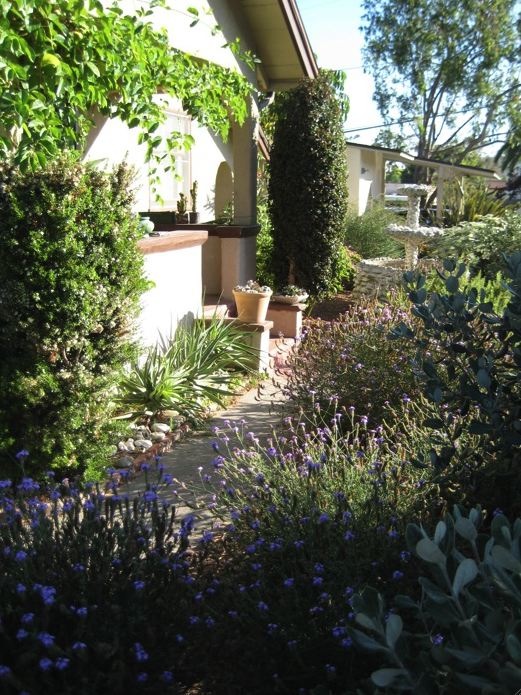
Barbara Flanagan's backyard a year after she planted low-water vegetation in keeping with Santa Barbara's Smart Landscape Program. New plants include Hummingbird Sage (foreground) and Catalina Ironwood, a plant that resembles marijuana (background). All photos: Barbara Flanagan
How high can a water bill be?
High enough to uproot my little life in a big way as soon as I landed in Santa Barbara, California. Much as my first city water bill here felt like a stiff rebuke, however, it turned into an invitation to my kind of paradise. Not some limbo of carefree sloth, but a place I enjoyed working hard to tend while noticing how the care was actually paying off all day, every day.
Here’s how my newly adopted town convinced me to become a better citizen and how the civic got personal. It only took three steps: Punish. Inspire. Reward.
First the city punished me with those high water rates, reminding me that tap juice is precious and getting still costlier. Next, the city inspired me with examples — from demonstration gardens to new manuals — showing how to replace my water-guzzling lawns with a lovely water-conserving landscape. Finally, the city rewarded me through the Smart Landscape Rebate Program by reimbursing me for half the cost of the water-wise plants that replaced my lawns. Ultimately, though, the real reward was discovering that I was really building a habitat —not just a playground for tiny wildlife, but a better understanding of all sorts of living neighborhoods, my street included.
My water bill triggered two kinds of payoff: one financial, the other — let’s call it mental. One month after I’d moved to a pricey-if-modest bungalow near downtown Santa Barbara, the city sent me a water tab that was not only stiff, but also judgmental. The bill was “tiered,” so the more water I used, the higher the price per gallon. Since the previous month was a rainy March, I’d irrigated nothing but me and my household chores. I had yet to spray the front and back lawns, rose bushes, plus a family of five citrus trees. What would I do during the dry half of the year here when all rain ceases? Work a night shift to pay for the water (plus the chemicals and fuel, and the labor of fertilizing, weeding and mowing lawns)?
I started to resent that turf even as I resisted the lawn-hating zeitgeist. The sellers’ family had proudly maintained my vintage lawn — founded by the great-grandfather, a carpenter who also built the 1920 house at its center — through a century of repeated droughts and El Niños. How could I think of slicing the family turf from the family home?

Former lawn and shrubs in Flanagan's front yard
Okay, yes, I’d been doing that back East since the 1980s. I’d removed an under-tree lawn and installed a checkerboard of local slates and sweet woodruff (only to see the new owners replace the oeuvre with a carpet of turf), and replaced flat lawns with terraces of woody perennial herbs. But I’d done those naughty non-lawns with the help of excavators and their earth-moving equipment. In Santa Barbara, I had no budget for men and machinery, or for anything so absurdly non-urgent as costly new plants.
Also, as a recent Easterner, I had no idea what so called water-wise, drought-resistant, low-water or native plants actually were. Mean, prickly things available in one shade of silvery blue-green? While growing up in LA, I watched my parents and their fellow settlers recoil at the sight of chaparral, the cover for baby-snatching coyotes and rattlesnakes. They peeled off that scrub as an act of health and safety, and civilized the frontier town with fresh sod kept alive by new-fangled networks of sprinkler “systems” that seemed as progressive as the new freeways. Back then, drenched gardens looked as gorgeous as gassed-up SUVs did in the ’80s. It was sparkling proof that we could move liquid resources across anyone’s mountains or deserts.
So what happened? As the thrill of vanquishing nature, along with distant nations, fades away, a new challenge pops into view: Let’s pay the real price of what we use. And, furthermore, let’s go easy on those natural perks. Once they’re gone, the buying is over.
Back to the water bills. Brain addled by the sun, perhaps, I opted to go for the rebate and build a water-conserving yard solo. Actually, I’d do it in two phases. In the first, two job-seeking sons of friends, plus my daughter’s ex-beau, would carve the yard up with picks and shovels. Then, I’d do the planting and mulching myself.
I called the city to apply for the rebate. But which rebate did I want? It offered three categories of options for homeowners, with a one-time, all-inclusive maximum rebate of $1000 per household. The city would refund half the cost of “water-wise” irrigation equipment (drip systems, sprinkler retrofits, laundry graywater systems). It would also refund half the cost of a smart irrigation controller that watered plants on an as-needed basis. And for those willing to remove all or part of their lawn, it would refund half the cost of mulch and water-wise plants replacing that bare patch.
I chose the planting option, aiming to (rarely) irrigate my new plants the artisanal way, with hoses moved by hand. But the requirements scared me. If accepted by the city’s pre-qualification inspection site visit, I’d have 60 days to replace my lawn with plants chosen from an official list. These would have to be installed, mulched with a 3-inch-thick layer, and accompanied by a planting list and receipts to be handed over during a final inspection.
Impossible. So I signed on.
It all started nicely enough. I filled out an application, and the first city inspector visited to photograph my extant lawns, front and back. I was in. The first hurdle was figuring out how to kill an existing lawn without Roundup. Internet expertise deemed all the possible methods of non-herbicidal lawn decimation tedious, exhausting, endless or, most dependably, futile. Disbelieving, I tried two techniques: ancient in front, modern in back. Jimmy, the ex, was a backcountry firefighter who battled the front yard with a pick ax, chipping at the dry clay while I worked the clod piles, separating the roots from the dirt. The process was everything the web experts had promised and more.
My new neighbors, who may have viewed me as a curiously pale alien with a strange car (Subaru with kayak rack), offered empathy over the sidewalk hedge as we turned grass into dust. “Ay. Mucho trabajo.” They were too polite to tell me the truth. Summer was the wrong season for planting. Once the spring rains stopped, local dirt hardened into brown concrete until fall rains loosened it up again.
Neighbors’ children watched the inanity from their balconies or, through the side yard’s wooden fence after they had poked out the knots for a better view.
Eventually, the kids mustered the courage to ask, “Barbara, are you farming down there? Are you — a farmer?”
“No, I’m just hoping all these plants will like it here and decide to stay,” I answered. “If they do, I’ll invite you over for a tour of the garden.”
In the backyard, I tried a newer and unsavory-sounding method of lawn-killing called sheet composting. The grass stays put while you smother it with overlapped sheets of cardboard, then bury the sheets under a thick blanket of mulch. To insert plants, you cut holes into the cardboard which is composting away. No one mentioned the work of accumulating and flattening enough boxes to create this dirty quilt. More endlessness.

Backyard lawn being smothered under layers of flattened cardboard boxes and mulch. Planting holes have been cut into the cardboard layer.
Inspiration was the next phase. Replacing a lawn with plants required design, and design required intention. How did these plants actually behave? What did I want each plant to do when and where? And what kind of changing setting would all the plants create as they grew up mingling and tangling together over the next couple decades of my lifespan — one they would outlive?
How could I squeeze this lifetime of work into a couple weeks? There were too many plants to list let alone befriend. In the so-called Mediterranean climate zones that produce drought-thriving plants, California has thousands, and thousands more are offered in southern Europe, and parts of Australia and South Africa.
To narrow the scope, I assigned myself a mission. Of the sturdiest, lowest-water plants out there, find those that would make food for me and/or for the cutest forms of neighborhood wildlife — birds, bees, and butterflies — while exuding maximum fragrance. After learning that the yummiest crops took the heaviest irrigation, I compiled a list of resinous herbs and berry-producing shrubs, all marginally edible, but fabulously non-needy.
Once again, government advice was a boon. Years ago, the state of California funded the Water Use Classification of Landscape Species project and created an inventory of nursery plants rated by their irrigation needs: the WUCOLS list. To plant a low-water garden, and to comply with the city’s rebate program, I’d have to choose listed plants deemed “low” or “very low.”
Next, I’d need to match faces to names and, after reading their profiles, visit the most loveable plants in real life. (Horticultural dating, in effect.) Again, I saw my tax dollars at work. Throughout downtown Santa Barbara, there were lovely, educational landscapes subsidized by the city: a community college and a public park with low-water demonstration gardens, brilliantly-xeriscaped public housing and public streets. Tucked into the foothills was the non-profit Santa Barbara Botanic Garden, a hillside devoted to California native plants and staffed with people eager to tell the whole romantic story of the intertwining relationships between flora and the local ecology.
Inside the SBBG bookstore, it was the prose of Carol Bornstein, and her co-writers of two California landscape books that alerted me to the poignant personalities of plants: “The delicate clover-like appearance of the redwood sorrel belies the tenacious character and specialized adaptation it requires to compete for light, nutrients, and water on the shaded floor of redwood...forests.” I nearly memorized her classic book California Native Plants for the Garden (2005) then devoured the next, Reimagining the California Lawn (2011) even though it arrived after my lawns had departed.
Finally, I compiled a plant list and took it back to the gardens for re-checking. There, I befriended still more plants and kept adding them to the list until time ran out. It was high time to start shopping. But where? When I took my long list of natives, and other water-wise plants, to local retail nurseries there were few to be found!
Next step: wholesale nurseries. Lo and behold, a few miles away, lay the nirvana of drought-resistant landscaping stock, San Marcos Growers. Before a backdrop of purple mountains, 20 acres of potted plants formed wonderfully fuzzy grids divided by dirt lanes. I opened an account, jumped into an electric cart, and ferried native specimens into my Subaru — over and over and over again — throughout the next weeks. In between trips, I dug new holes for the next delivery, mulched, and watered as fast as I could.
The County of Santa Barbara, dumped three free mountains of dark brown, steaming mulch into my driveway (delivery: $40 each truck). An arborist dumped another couple tons of wood chips at no charge at all. From there, I eventually wheel-barrowed a grand total of 8 tons to all corners of the lot. Punishing as it was, I had to admit that being outside, working harder than ever before, was not only possible, it was sort of glorious.
Sixty days later, my yard was a sorry sight, however. A motley brown expanse dotted with lonely green clumps. A costly exercise in futility. Would I fail the post-installation inspection based on brute homeliness?
Cathy, a cheerful public works official, arrived to examine my lawn-free yard. “Your plants will grow,” she said. “And your check for $900-plus will arrive in the mail shortly.”
I coddled my little plants through the rest of the dry summer and fall by worrying, fluffing the mulch, feeding them too much or, too little water. I didn’t know. Once the winter rains started, with record drenching, the garden’s fate was out of my hands. While the news reported flooded roads in Santa Barbara and collapsing hillsides in L.A., my puny transplants prevailed somehow, but failed to thrive. How had I failed them? What more could I do?

Front yard, ready for its garden tour. Featured are Cedros Island Verbena, Giant Burmese Honeysuckle, Golden Torch Aloe, Rosemary Golden Dust, Toyon and Pineapple Guava.
Stop worrying. As this final step coincided with the longer and warmer days of spring, the combination of benefits, more sun and less angst unleashed the final reward. Growth! Every plant was bristling with new appendages — tendrils, stems, stalks, trucks — covered with leaves of every conceivable green. As summer took over, plants took turns flashing their blooms then simmering down while others took over. Hummingbirds and butterflies arrive dawn to dusk following the blossoms’ progress. Each day the plants stretch out in new ways, inching along the ground, angling into shafts of sunshine, reaching straight up with uncanny tenacity, showing what happens in the wilderness when they’re left to their own devices.
Without the city’s rebuke and reward, I never would have done the work to earn this ever –enriching outcome. How can I ever repay that incitement?
Last week I heard a polite knock at my door. Outside were three little boys — Raul, Alexi and Rodrigo — looking terribly hopeful.
“Barbara, can we please have the garden tour now?”
Author's Note: Although the city has no way to measure the amount of water the rebate program is saving, it does know that irrigation accounts for 50 to 70 percent of average water use in Santa Barbara’s households. Improving irrigation equipment, or removing irrigation dependents like lawns, protect water supplies in times of drought by saving vast quantities of water over time. Sending this message is not so easy, however. Since 2009, only 100 applicants have earned the rebate with another 100-plus on the way. Get with the program, SB!
